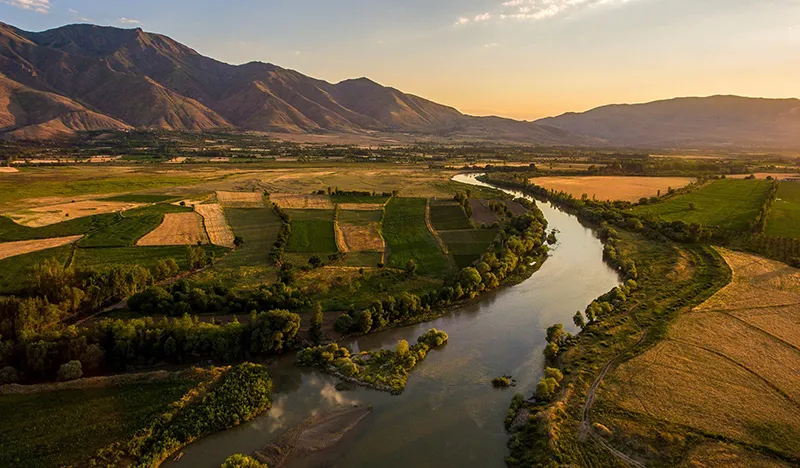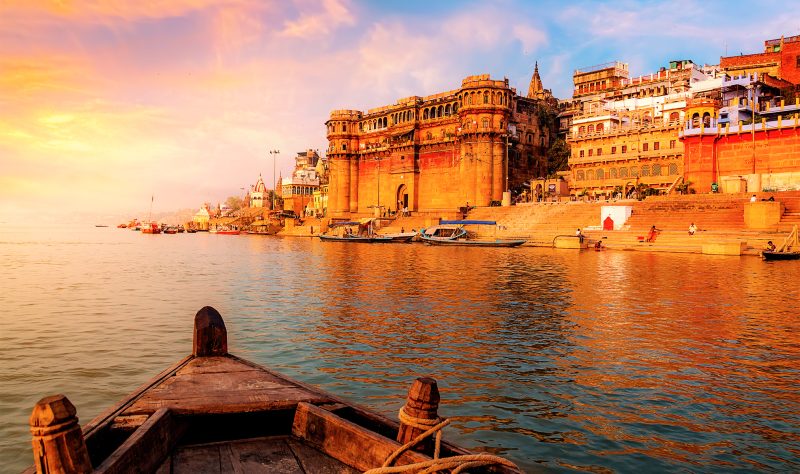The Euphrates is a river that flows through several countries in the Middle East, including Turkey, Syria, and Iraq. The Euphrates is one of the two major rivers in the region, the other being the Tigris.
History
The banks of the Euphrates River were inhabited many thousands of years ago. In ancient times, Mesopotamia, an area whose name means “land between rivers,” was associated with this river. Indeed, this historic region was located in the middle and lower reaches of the two rivers, the Euphrates and the Tigris (their confluence did not occur until the first millennium B.C.).
Here, in Mesopotamia, emerged one of the oldest civilizations of the ancient East – Sumer, which existed in the IV-III millennia BC (its territory extended to the south of modern Iraq). It is believed that the Sumerians were the creators of cuneiform writing, in addition they widely used the technology of the wheel, and as a building material early began to use burnt bricks. At the turn of the IV-III millenniums BC the cities of Sumer had an irrigation system for the fields, water for which was taken from the Euphrates.
However, with all their civilization the Sumerian city-states were in constant conflicts with each other: the reason for internecine strife was the desire to gain power over the rest of the land of Sumer. A sad end awaited the great civilization: by the beginning of the third millennium, only ruins remained in place of the former richly built cities, filled with sand.
The legendary Babylonia also flourished in the Mesopotamian lands. At the best of times the power of the Babylonian rulers extended to the lands of Syria, Turkey, Saudi Arabia and other states. The state was named after its legendary capital, Babylon, which became the archetype of a rich, powerful, but also immoral city. The period of the greatest prosperity came during the reign of Nebuchadnezzar II (600-562 BC). During his reign the population of the capital was about 200 thousand people, and the beauty and security of the city was the envy of many. However, with the death of the king Babylon fell into decline, and after several conquests in the II century BC the history of the kingdom ended in destruction.
In the 4th century, the region of Mesopotamia was conquered by Alexander of Macedon and later was ruled by the Sassanid (3rd-7th centuries) and Seleucus (4th-2nd centuries) states. From 1534 the territory of Mesopotamia belonged to the Ottoman Empire (the future Syria and Iraq were also under Turkish control).
Europeans first took a practical interest in the river during Ottoman rule. In the early 19th century, the military officer and explorer Francis Chesney (1789-1872) suggested that a more convenient trade route to India could be built through the river valley. Chesney’s expedition, which began in 1836, was successful. Later, in the second half of the 19th century, the British government had plans to build a railroad in the valley, but the idea was not realized. After the collapse of the Ottoman Empire in 1918, the League of Nations gave Britain a mandate (right of external administration) over the Mesopotamian lands. In 1921, the Kingdom of Iraq emerged in the region, and in 1923, the Turkish Republic was proclaimed. Syria appeared on the world map in 1946.
In the 1970s, the traditional use of the Euphrates for irrigation purposes was taken to a new technological level. A series of dams were built on the river, which not only allowed the use of large volumes of water for irrigation, but also generated electricity. However, many riparians were forced to relocate to other areas because of the flooding of their native settlements caused by the construction of the dams. It is estimated that 382 villages were affected and about two hundred thousand people were forced to relocate.
Geography
The Euphrates River is the largest river in Western Asia. It began in the mountains of the Armenian highlands, and then its route passes through the territories of present-day Iraq, Syria, and Turkey. Breaking through narrow mountain gorges, the Euphrates rises up into the vast Syrian plateau and then descends to the Mesopotamian lowlands, through which most of the great river’s route passes.
Most of the regions through which the Euphrates flows are arid, and hence the river’s waters are replenished mainly in the mountainous region at its source (the main mode of feeding is snow and rain).
In spring there is a high-water period, but in summer it is low-water season.
The construction of dams and the subsequent flooding of coastal villages served as a lesson for the Turkish authorities. They began to use modern technology wisely. New hydraulic structures reduced the risk of flooding and allowed a more rational use of the river’s resources. These achievements are particularly significant in light of the fact that today a huge number of Euphrates Basin residents depend on the water and electricity supplies provided by the river.
The Euphrates not only serves the coastal inhabitants. It has become an important political field. Interestingly, the possible construction of water facilities on the banks of the Euphrates and Tigris was considered in the first half of the 20th century. Since the interests of the three countries intersect in this case and their well-being largely depends on the proper use of the Euphrates waters, it was decided to agree with the neighbors on the slightest artificial changes in the flow of the Euphrates. Thus, in 1946 a treaty was signed between Turkey and Iraq, which obliged to submit all proposed hydraulic projects for discussion. Despite this, the construction of dams in the 1970s almost led to a war between the two countries: the water level in the section flowing through Iraq had dropped drastically and the government threatened a military attack and bombing of the structures if more water was not released into the country. Fortunately, the problem was solved without the use of force.
The thousands of years of human exploitation of the Euphrates River has had a strong influence on the soils, which were often used for agriculture (crops or for grazing goats and sheep). Despite pervasive civilization, islands of wildlife can still be found in some parts of the former Mesopotamia. In the wet areas there are various species of oaks, pistachio trees, and bush plants of the rose family. Some species of grain plants also grow in the Euphrates Basin wilderness, including single grain, emmer wheat, rye, and oats.
A rich fauna has also been preserved far from human settlements. Predators are especially abundant in this area: Syrian brown bears that live in southern Turkey, wolves, jackals, foxes, lions and leopards so travelers have reason to worry for their safety in the wild forests of the Euphrates.
General Information
- Other basin countries: Syria, Turkey, Iraq, Jordan, Saudi Arabia.
- Major cities: Deir ez-Zor (Syria), Ramadi, Samawah (Iraq).
- It has its source at the confluence of the Karasu and Murat Rivers.
- Tributaries: Tohma, Geksu, Balikh, Kabur.
- Tributaries: Al-Asad (Syria).
- It flows into the Tigris River, forming the Shatt el-Arab River. It is fed by snow and rain.
- Length: 2,780 km.
- Basin Area: 765,800 km2.
- Average water flow: at Hit (where navigation begins) 840 m3 /s, below it drops to 300-400 m3 /s.
- Maximum water flow rate: 2,514 m3/sec.
- Minimum water flow: 58 m3/sec.
Climate and weather
- Tropical and subtropical.
- Average annual rainfall: in Syria – 600-900 mm in the north, and up to 500 mm inland. On the territory of Turkey, it is about 700 mm.
Economy
- The river is used for irrigating fields and generating electricity.
- Industries: shipping and shipyards.
- Fishing.
Attractions
- Ruins of ancient cities (Babylon, Ur, Mari).
-
Turkey
- Gaziantep: Museum in Ziugma (ancient center with monuments, sculptures, mosaics), Sharkly Cave (found implements dating back to 60 BC).
-
Syria
- Aleppo: Aleppo Citadel (12th century, built on the site of an ancient acropolis), al-Jami al-Kabir Mosque (“Great Mosque,” 1090 c.), Jami Kikan Mosque (13th century), Kalb-Lawzi Church. Aleppo Archaeological Museum. The Old City of Aleppo was inscribed on the UNESCO World Heritage List in 1986.
- Dair Al Zawr: Arab Cultural Center, City Museum, and the Dair Al Zawr Suspension Bridge.
-
Iraq
- Ramadi: Central Mosque: Kerbela: ancient mosques and about 20 ancient madrassas.
Fun Facts
- The Tigris and the Euphrates once flowed parallel to each other and their path ended in the Persian Gulf. However in the first millennium BC their course changed and they merged to form the Shatt el Arab.
- In the Old Testament of the Bible, the Euphrates is called “Prat”, and is referred to the four rivers that flowed from the Garden of Eden and were the arms of a single stream that served to irrigate the lands of Eden. This river is subsequently mentioned more than once in the parables of the Old Testament.
- Some of Mohammed’s prophecies are interpreted as hinting at the countless treasures to be revealed to men when one day the Euphrates runs dry. “The Euphrates reveals its treasures. He who sees it must not take any of it,” is what the great prophet said, but no one knows for sure whether he meant gold or something much more valuable.
- As scientists suggest, one of the reasons for the birth of great and prosperous ancient civilizations on the banks of the Tigris and Euphrates is quite simple: Mesopotamia has very favorable climatic conditions for life.
- In 2007, an Iraqi fisherman caught a two-meter-long white shark in the Euphrates. In search of food, predators swim several hundred kilometers from the shores of the Persian Gulf to Baghdad on both the Euphrates and the Tigris.




